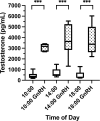Baseline Testosterone Levels Peak During the Inactive Period in Male Degus (Octodon degus)
- PMID: 40800110
- PMCID: PMC12342971
- DOI: 10.1093/iob/obaf033
Baseline Testosterone Levels Peak During the Inactive Period in Male Degus (Octodon degus)
Abstract
The steroid hormone testosterone is important for stimulating male reproductive processes including territory acquisition, mating displays, and spermatogenesis. When examining the relative effects of testosterone on reproductive processes, it is most reasonable to focus on peak baseline testosterone levels, especially for reproductive processes that may occur during specific times of day, such as mating and spermatogenesis. However, some studies have not found consistent positive relationships between circulating testosterone levels and reproductive variables. These nonsignificant relationships could be driven by methodology, as most studies in wild, free-living animals collect blood samples during an animals' active period, yet many species show peak baseline testosterone levels during their inactive period. This may be the case for the common degu (Octodon degus), as field and laboratory studies have exclusively sampled these diurnal rodents during their active period and have found little correlation between testosterone levels and reproductive success. In this study, we measured testosterone levels in captive male degus every 4 h across a 24-h cycle to test the hypothesis that male degus demonstrate diel variation in their baseline testosterone levels. We saw significant variation in male degu baseline testosterone levels over a 24-h period, and our prediction that baseline testosterone levels would be higher during nighttime (inactive period) timepoints compared to daytime (active period) timepoints was supported. However, nighttime baseline testosterone levels were still several magnitudes lower than testosterone levels after a gonadotropin-releasing hormone (GnRH) injection. While GnRH injections significantly increased circulating plasma testosterone levels during any daytime time period, we found no significant correlation between nighttime baseline testosterone levels and post-GnRH testosterone levels, which suggests GnRH-challenges during the daytime cannot be used to approximate or estimate nighttime baseline testosterone levels. These findings expand our knowledge surrounding testosterone dynamics and suggest that future studies should take into account the time of day when sampling testosterone and other hormone levels.
© The Author(s) 2025. Published by Oxford University Press on behalf of the Society for Integrative and Comparative Biology.
Conflict of interest statement
The authors declare no competing interests.
Figures





References
-
- Apfelbeck B, Mortega K, Kiefer S, Kipper S, Goymann W. 2013. Life-history and hormonal control of aggression in black redstarts: blocking testosterone does not decrease territorial aggression, but changes the emphasis of vocal behaviours during simulated territorial intrusions. Front Zool, 10:8. - PMC - PubMed
-
- Balthazart J. 1976. Daily variations of behavioural activities and of plasma testosterone levels in the domestic duck Anas platyrhynchos. J Zool 180:155–73.
-
- Blottner S, Franz C, Rohleder M, Zinke O, Stuermer I. 2000. Higher testicular activity in laboratory gerbils compared to wild Mongolian gerbils (Meriones unguiculatus). J Zool 250:461–6.
-
- Book A, Starzyk K, Quinsey V. 2001. The relationship between testosterone and aggression: a meta-analysis. Aggression Violent Behav 6:579–99.
-
- Contreras LC, Rosenmann M. 1982. Thermoregulation in the testes of Octodon degus: a nonscrotal rodent. Physiol Zool 55:144–7.
LinkOut - more resources
Full Text Sources
